MACRO OCTOBER IN MARLERA - Episode Three - ON THE FIFTH OF OCTOBER.
As I repeat in each episode, not always at the beginning, Marlera is a coastal area near the village of Liznjan, about five or six kilometers from where I live. Since the place is only a short drive from my house and supports a nice diversity of wild plants and small arthropods, I visit it quite often. During this unusually warm October, almost every day.
Exploring the same area year after year, practically since childhood, can get a bit repetitive but surprisingly less than one might expect. The amount of details and species one can find is staggering and every new day can show you the same plants & animals in different situations, so even when repetitive things rarely get boring. To encounter something completely new is a rare occurrence though, but ...
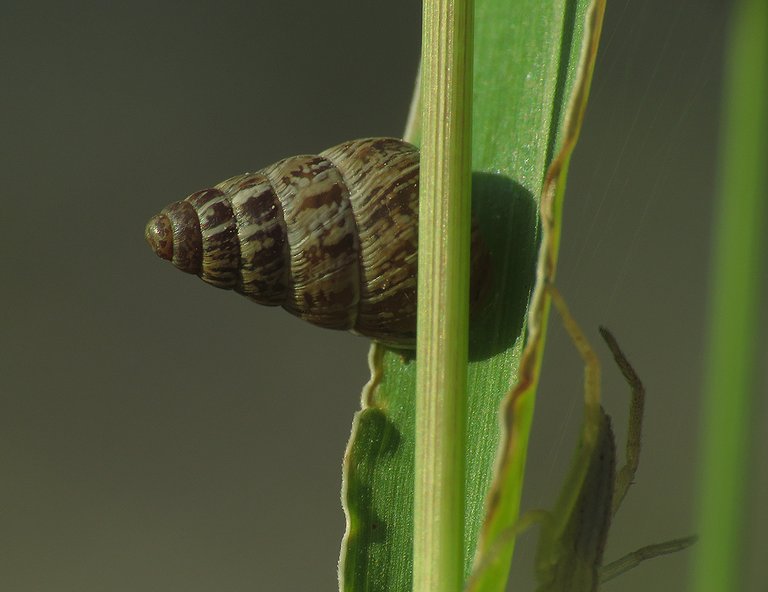
... but that's exactly what happened a week ago, on the fifth of October. I found a tiny snail I never saw before. I mean, I saw only the shell attached to a leaf of grass, the snail was hidden inside. In the following photograph ...
... you can see the Tibellus oblongus, a spider from the Philodromidae family that was resting, partially supported by a few silky threads, on the other side of the same leaf, very close to the snail.
While photographing this Pisaura mirabilis spider from the Pisauridae family that was resting on one of the low-growing plants around the fairly tall grass, I thought about how great it would be if I could see and photograph one or more of those snails actively crawling around. Since the weather was hot, not particularly dry but far from being humid either, I wasn't seriously expecting that, just nursing a vague hope. I thought: "With a few attractive shots of active snails that belong to a species I never encountered before, the post I envisioned would be so much better."
This is the Echium italicum, a plant that at this stage of its development forms a rosette of leaves low on the ground. At some point, Echium italicum will grow a fairly tall, robust stem with many flowers, but for now, the plant has only a bunch of leaves to show. On one of its juicy, hairy young leaves ...
... I photographed a tiny leafhopper nymph. Many leafhoppers present in this area are very similar and hard to identify even in their adult stage. Trying to identify a nymph is even harder. That's why I won't tell you the name of the species this time. But I can tell you what family it belongs to. The family is most certainly Cicadellidae.

On another leaf of the same plant, I photographed an adult Recilia schmidtgeni leafhopper that wasn't much bigger than the nymph shown in the previous picture. About half an hour later ...
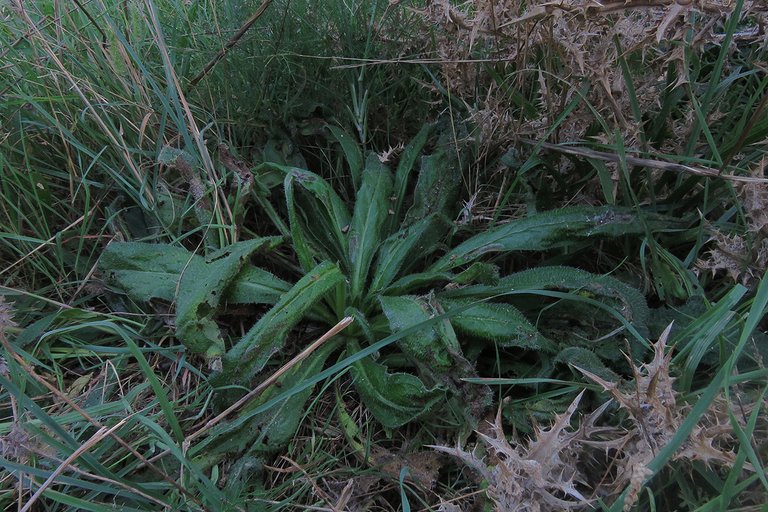
... on another Echium italicum plant ten or twenty meters further ...
... I came across a mollusk I was hoping to find. The snail was crawling from the well-lit place toward the shady one when this photograph was taken. I didn't find only one snail, in the following shot ...
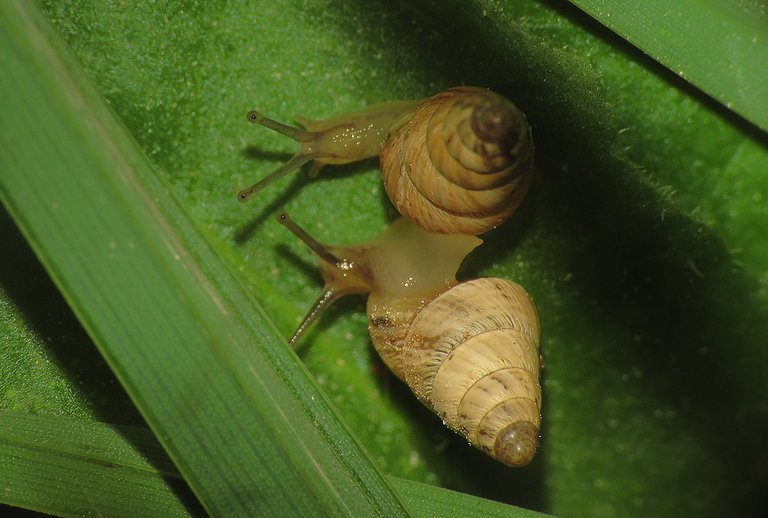
... you can see two of them next to each other.
I didn't know what species I was observing and photographing on the fifth of October but today, while preparing this post, after a fairly short Internet search, I found out that this is the Cochlicella barbara, a pulmonate snail from the Geomitridae family.
The species is native to the Mediterranean parts of Europe but it was introduced in the coastal areas of England, South Africa, and Australia.
The snails didn't mind the flash of my camera nor the invasive proximity of its lens, but if I touched the leaf on which they were crawling even the slightest, they retreated into their shells with surprising speed. I don't know how it came to be that I never encountered these snails before. They are pretty small, so maybe I just didn't notice them. Maybe they are well-hidden most of the time. Many snails are active mostly or only during the night. Who knows.
I saw plenty of them on the fifth of October, late in the afternoon, but when I revisited the same place two more times, I didn't see any.
This Cochlicella barbara snail with just its upper tentacles peeking from the shell has a very cute, cartoonish appearance.
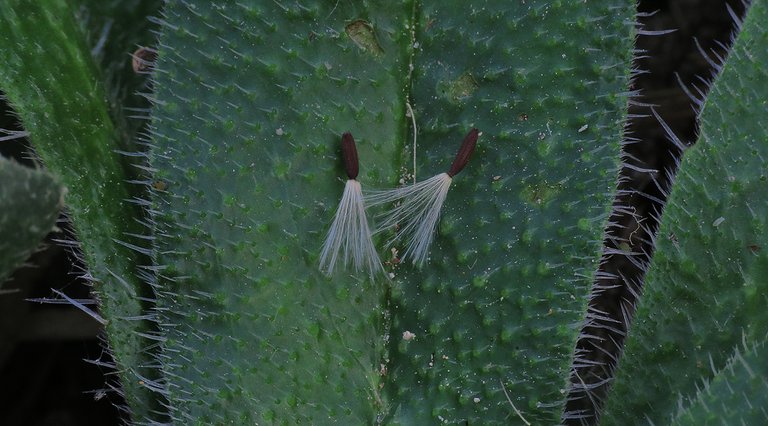
Here you can see the seeds fallen from one of the taller neighboring plants.
In this photograph, I used the macro lens to get closer and take a better look at the details. I think that these seeds belong to some plant from the genus Sonchus in the Asteraceae family, but I could be wrong.
Here you can see a leafhopper that I wasn't able to identify. The family is Cicadellidae - that's for sure, and the genus is probably Aphrodes, but I don't know what species exactly is this.
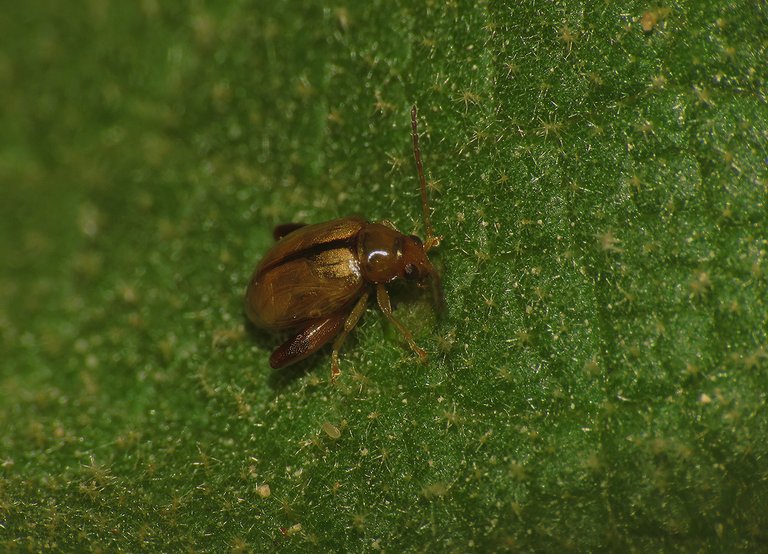
This is the Longitarsus exoletus, a beetle from the Chrysomelidae family.
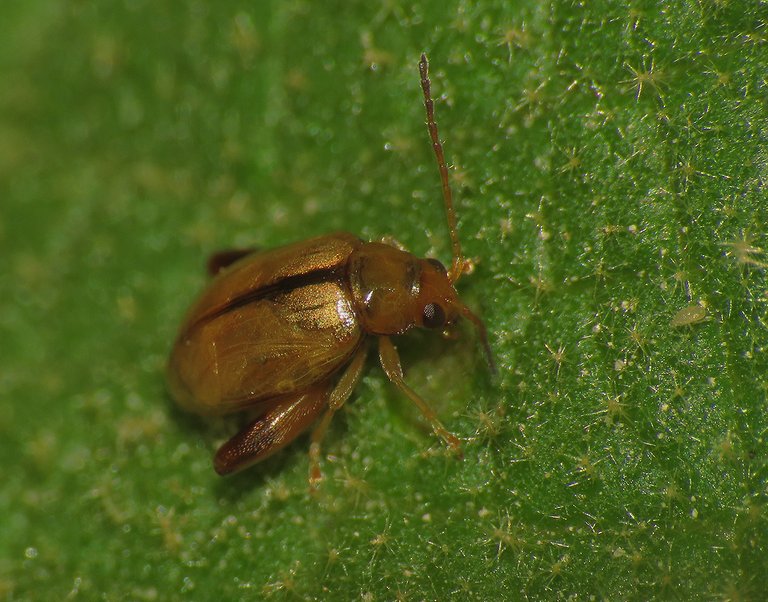
The tiny beetle was chewing the upper surface of a juicy leaf, but since I forgot to photograph the entire leaf on the fifth of October, I couldn't identify the plant today.
Pezotettix giornae is a grasshopper species I encounter very often, and therefore a species that appeared in many of my older posts. You can see a mating pair in this photograph. The thing that makes this shot stand out from quite a few other Pezotettix giornae portraits I uploaded so far on Hive, is the color of the female. The usual color of these grasshoppers is the one seen on the smaller male. While the species is a regular encounter, a pair like this has a bit of rarity value for me.
Here you can see another Pisaura mirabilis. The species was introduced earlier in the post. The spider shown in this shot was resting on the leaf of the Malva sylvestris plant. In the following photograph ...
... you can take a look at the Artemisia absinthium leaves.
On that relatively tall, robust herbaceous plant with a strong bitter aroma and quite a few beneficial properties ...
... I photographed this fairly small, still juvenile spider from the Oxyopidae family. The name of the species is Oxyopes heterophthalmus. This is an ambush predator that doesn't spin webs, but ...
... but uses its silk in other ways. In this shot, the flash of my camera somehow revealed the single thread coming from the spider's abdomen.
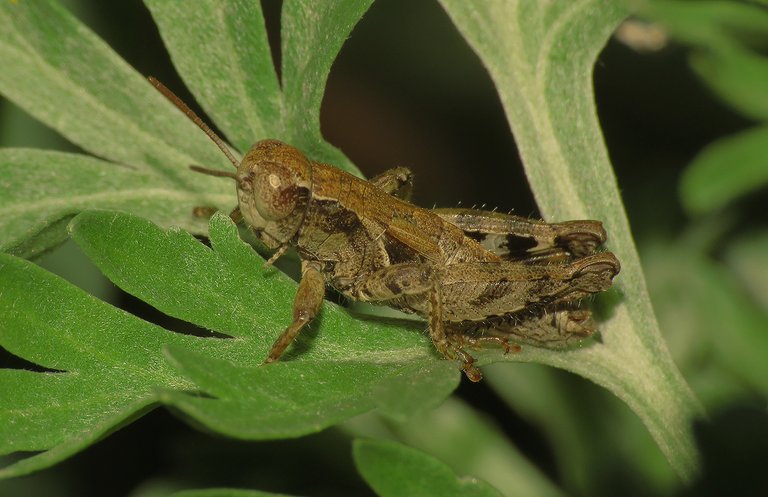
On the same plant, I also photographed another Pezotettix giornae grasshopper ...
... and yet another Pisaura mirabilis spider.
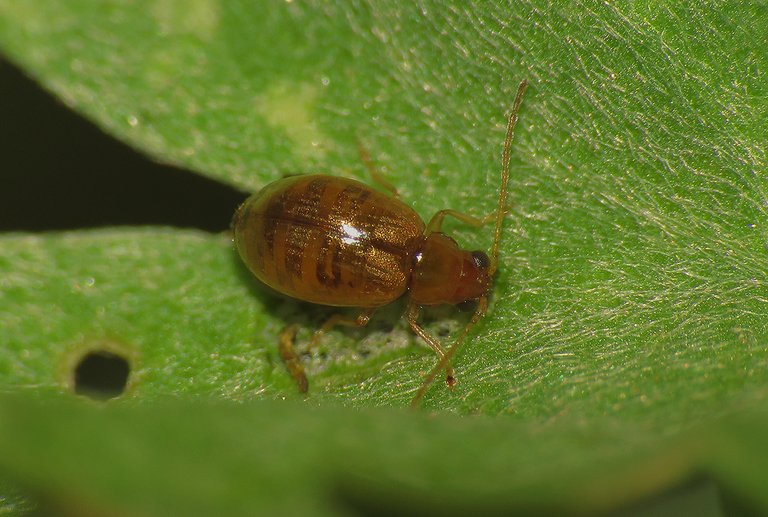
Here you can see a tiny beetle chewing the upper surface of the Artemisia absinthium leaf. I'm pretty sure that this beetle belongs to the genus Longitarsus, the family is definitely Chrysomelidae, but I wasn't able to identify the species.
AND THAT'S IT. I HAVE NOTHING ELSE TO SHOW IN TODAY'S EPISODE. AS ALWAYS HERE ON HIVE, THE PHOTOGRAPHS ARE MY WORK.
The following links will take you to the sites with more information about the protagonists of this post. I found some stuff about them there.
https://en.wikipedia.org/wiki/Tibellus_oblongus
https://en.wikipedia.org/wiki/Pisaura_mirabilis
https://en.wikipedia.org/wiki/Echium_italicum
https://en.wikipedia.org/wiki/Leafhopper
https://truehopperswp.com/species/recilia-schmidtgeni
https://en.wikipedia.org/wiki/Cochlicella_barbara
https://en.wikipedia.org/wiki/Aphrodes
https://en.wikipedia.org/wiki/Longitarsus_exsoletus
https://en.wikipedia.org/wiki/Pezotettix_giornae
https://en.wikipedia.org/wiki/Artemisia_absinthium
https://en.wikipedia.org/wiki/Oxyopes_heterophthalmus

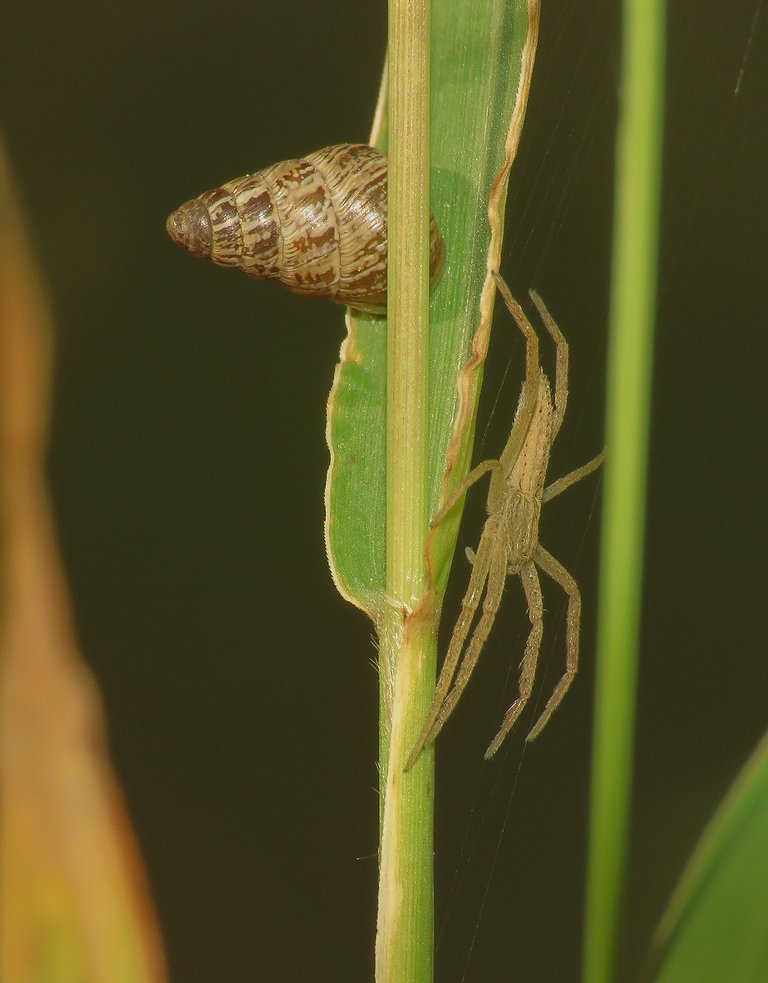
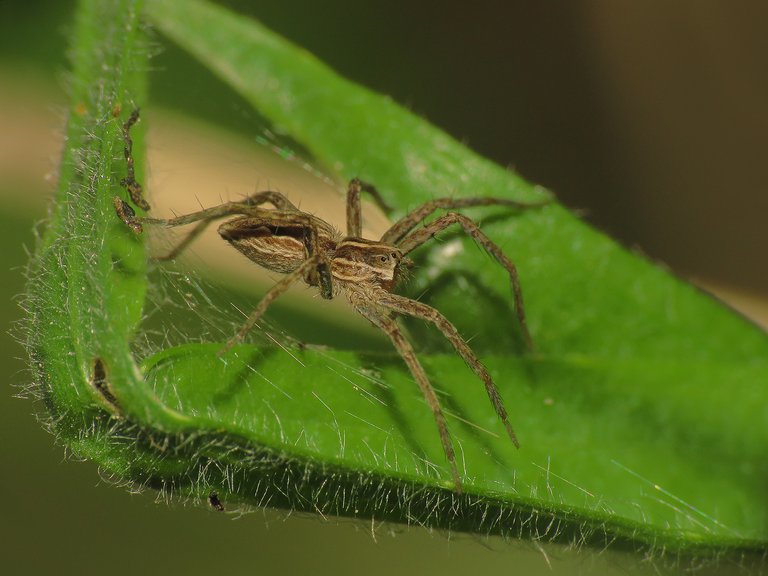
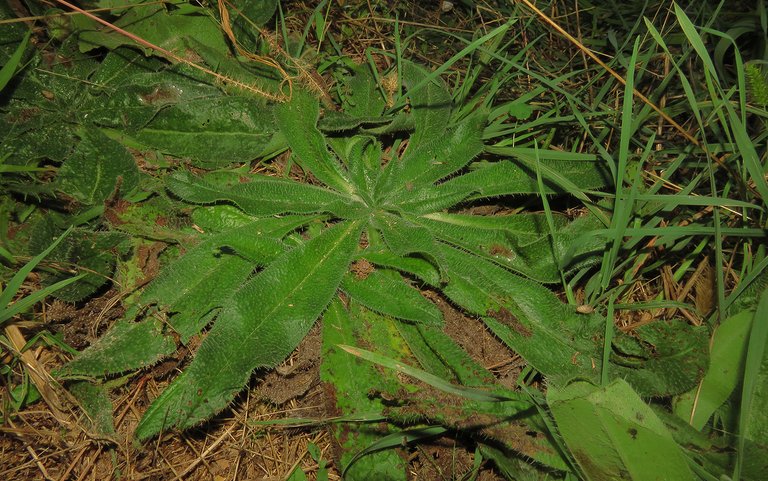
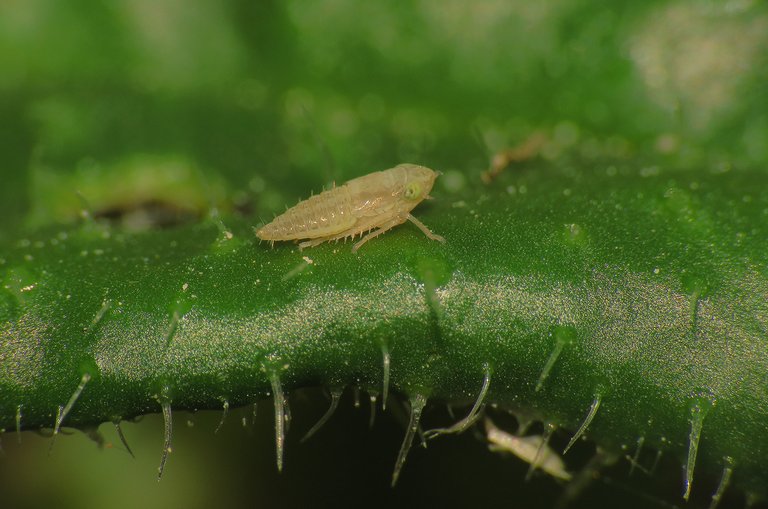
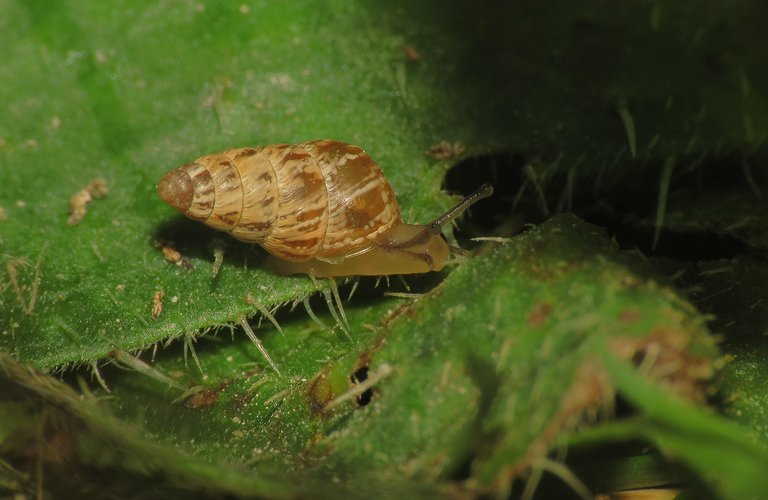

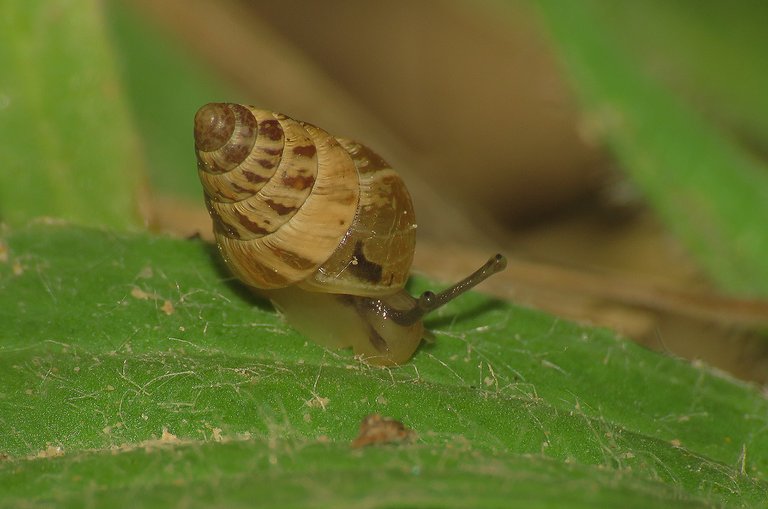
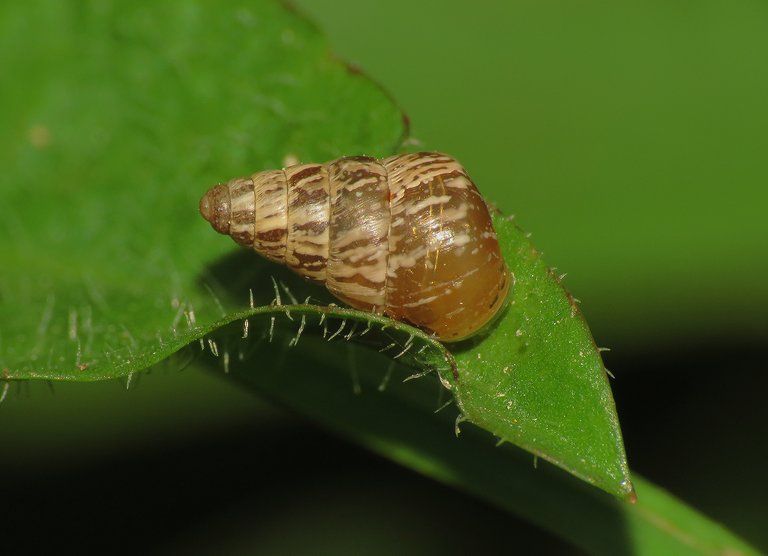
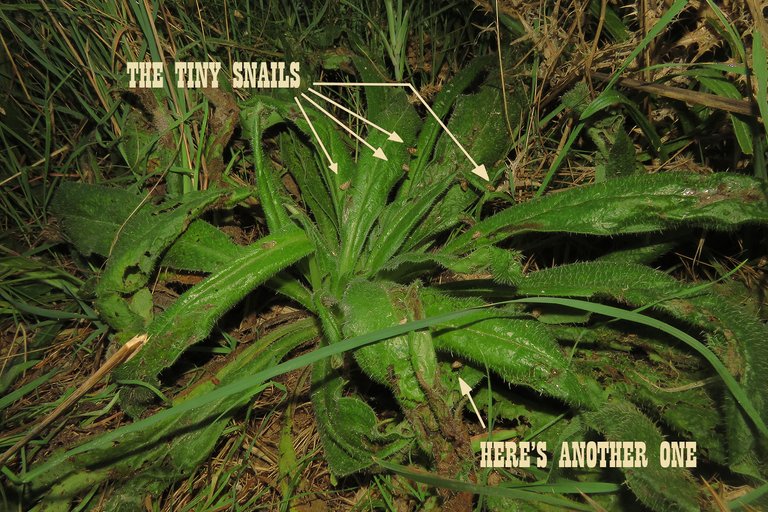

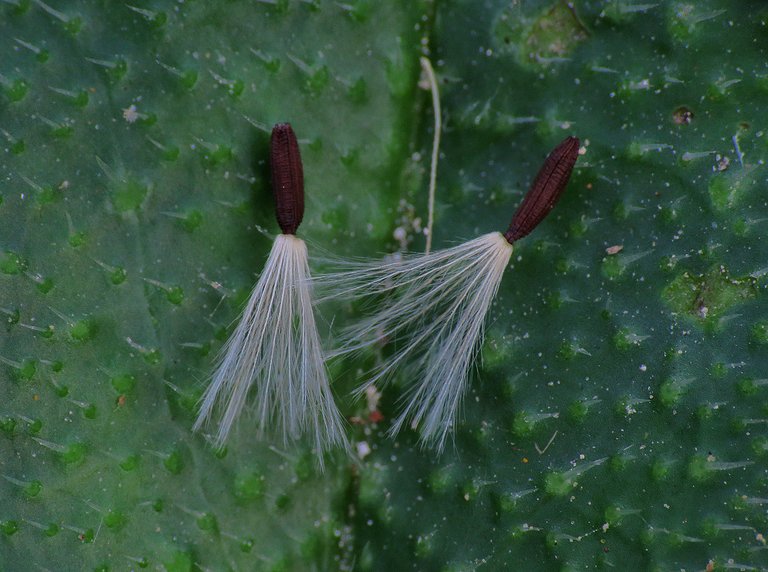
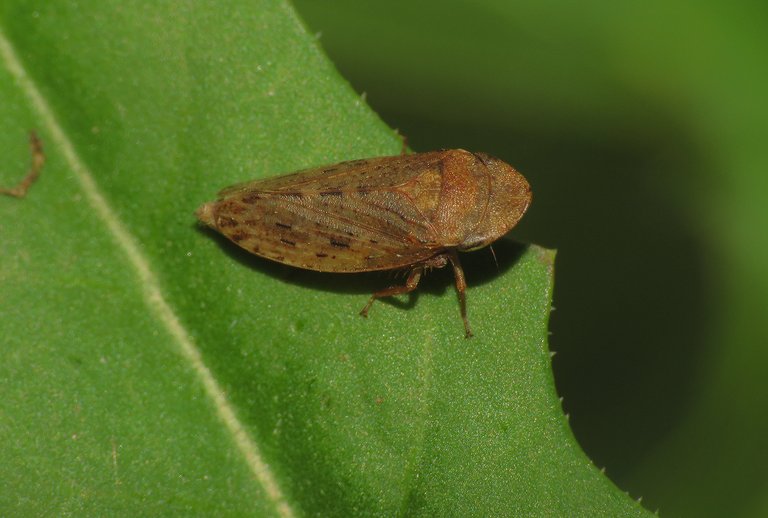
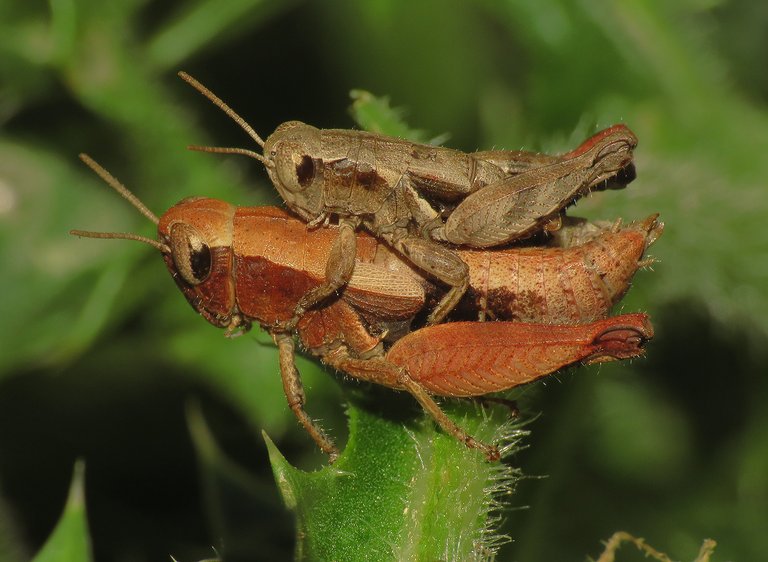

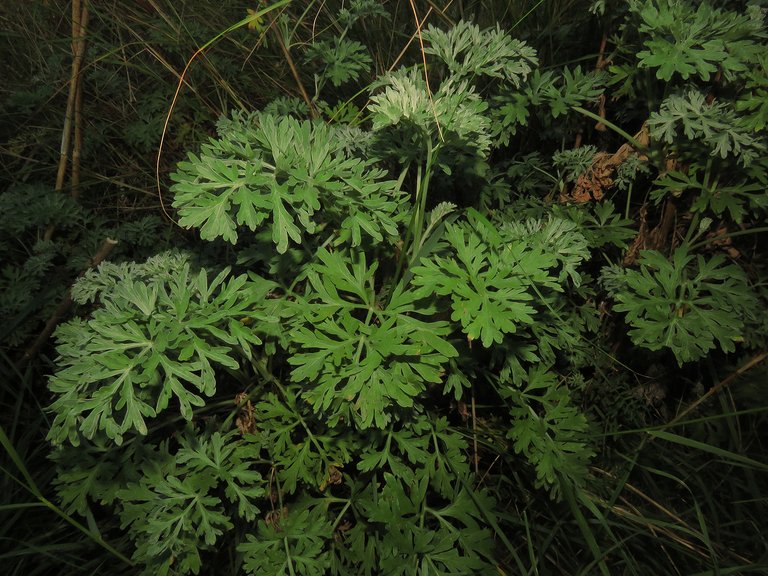
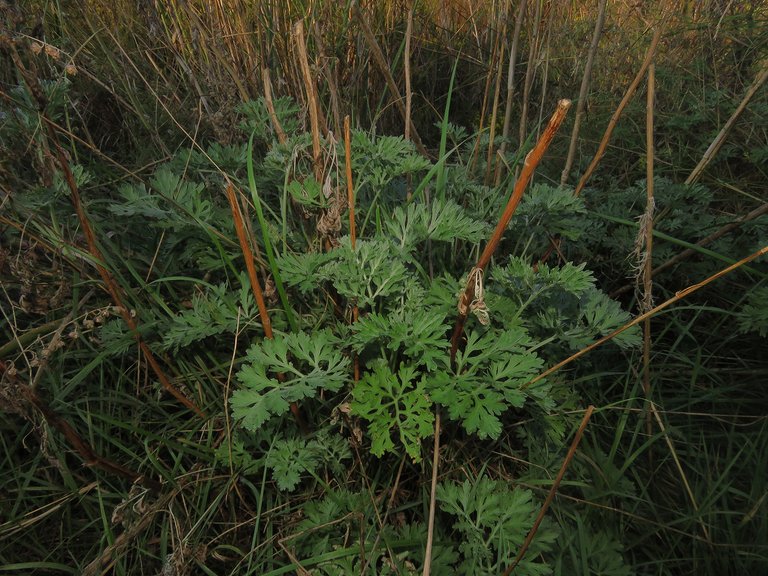
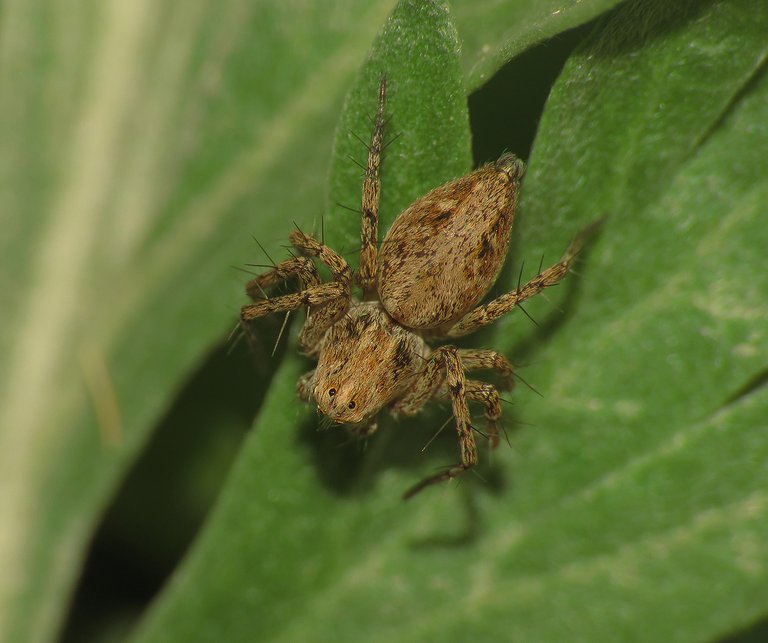
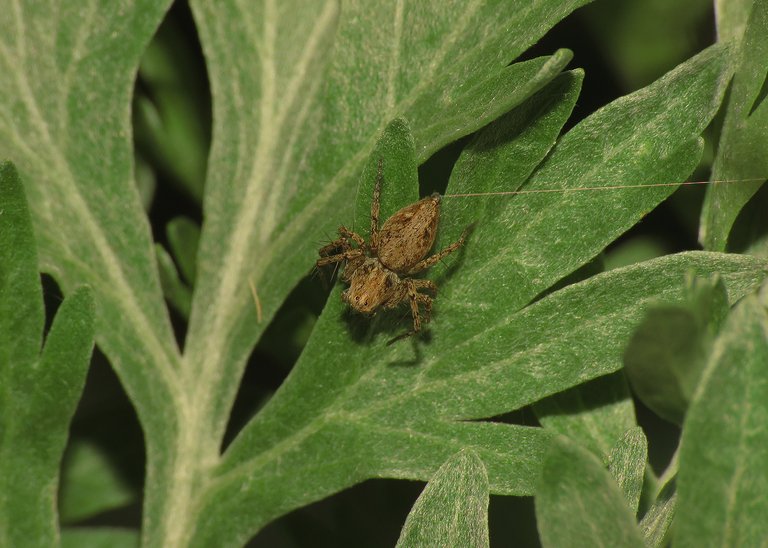
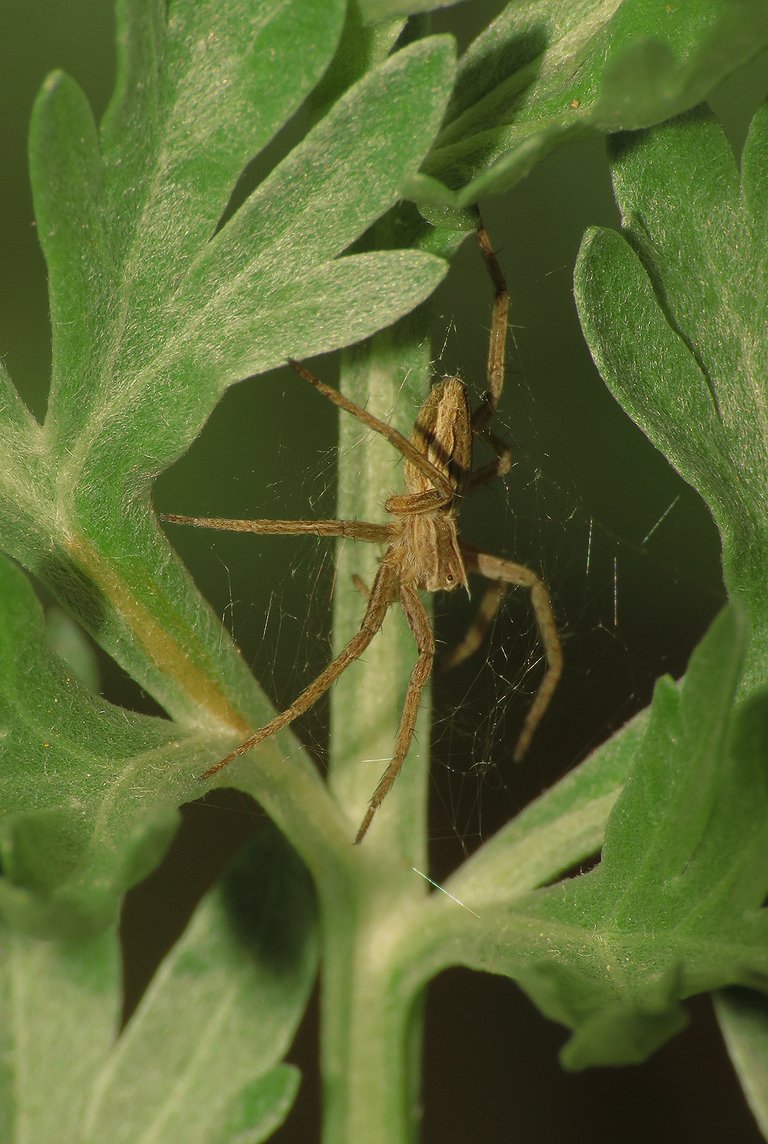
Absolutely gorgeous photography and who knew how much life was in that small little area.
When I'm with the macro lens, I'm always amazed by what I find in my area. Sometimes I daydream about how crazy and beautiful would be to explore a tropical area with lush forests that way. 🙂 Glad you like the post. Have a great day.
There have been a lot of times where I have thought about how much fun it would be to be tiny enough to pick and harvest the individual trichomes on my weed and smoke just those...
Although that leads to a bunch of bigger questions.
Phenomenal post thank you very much again.
😃
You would never know how beautiful nature is till you pick up and camera and be intentional about it. This is beautiful, dear.
True. 🙂 It takes a bit of time and effort to explore the details in nature. Wonderful things can be found practically everywhere not just in famous National Parks and those kinds of places.
Grasshoppers are enjoying! I didn't know a male can be so small comparing to a female one!
On the other hand, the snails are trying to make enviornment suitable for meeting, it seems. All the best for them.😜
Beautiful photography borjan. Thanks for sharing such natural beauty, nonstop.
Thank you. 😃 Glad you enjoyed the mollusks and company.
You are always giving us the beautiful nature back to back. Well-done 🙌 The photographs are astonishing.
You are welcome🤗
Shell is looking very clear and how beautifully nature has created them.
The hugging grasshoppers look very unique and They look very romantic
🙂

You're welcome
I love your photos about nature and how you share them. Keep up the good work bro and keep us updated
You are welcome brother
Although I so not like spiders and crasshoppers jumping to me your photography is absolutely gorgeous and very interesting article.
Definitivamente la foto es la del 🐌 muy original 😃 al estilo @borjan.
🙂
Super macro shot you have here. Looking so 😊
You're welcome 🤗😁
Wow, what a beautiful photographic view with various kinds of unique animals. This is the first time I have seen these animals
Thank you 🙂 Glad you like this snails-insects-spiders stuff.
I had a conversation with the Betty the other day... And we came down to the conclusion that you are one of the better photographers out here in Hive... And in truth there are many who take better photos than you. I don't mean this in a bad way but you should know there are always a few better than ourselves... ALWAYS!
BUT
in terms on consistency, you have it bud... You have it... You never dissapoint! Keep it up bud!
😃 Is great to hear such a reasonable compliment that doesn't go too far. 😂 I agree, many people know how to find or create great stuff with the camera, and the best one at that probably doesn't even exist, it's not like in sports where you can clearly measure the achievements and easily establish a hierarchy. But even so, there is always someone better, that's true. 😀 Glad you like these posts, this comment is a great incentive.
For some reason, after multiple tries, I was unable to load a single one of these photos. I've had trouble with it loading all of them for weeks now. Might just be my ancient computer...
Sometimes it happens ... even with my new, pretty powerful machine. Usually doesn't last long ... in my experience.
I can relate with regards to frequently visiting an area. I find that there's always something different - making each adventure unique. I must say, that you are brilliant at spotting the insect life! I'm still trying to 'tune in'.
There's something round these parts which looks like that 'Echium italicum'. Perhaps it's the same thing? Some sort of weed on the grass - with the root structure kinda 'tapping down'. Anyway, awesome post as always my friend!
According to Google, it shouldn't be Echium italicum which is still local to these parts, but Google isn't a guarantee - so who knows. If the habitat is similar, a stony one near the sea, if the climate is relatively similar, plants of different kinds can look pretty similar.
Lol.. maybe I'm way off haha. My post of September 12th shows me deweeding a bunch.
I'll take a look now 🙂
The grasshopper in that post is amazing. I envy you that insect! Looking at the vegetation in your posts in general looks a lot like looking at home! Didn't imagine that our areas have so many similarities. Can't tell you exactly about Echium italicum because is hard to be sure, I'm not an expert, but many things look the same.
Yay! 🤗
Your content has been boosted with Ecency Points, by @ma3str0.
Use Ecency daily to boost your growth on platform!
Support Ecency
Vote for new Proposal
Delegate HP and earn more
Reviewed and Approved for an Ecency boost. Keep up the good work.
Thank you. 🙂
You're welcome
I really like the long feathery threads on the the seeds from the Sonchus plant, very pretty indeed. Snail shells have the most fascinating pattern, and shaped like a conical "ice cream cone" but (without the ice cream) !LOL 🤣
Stay !ALIVE and enjoy the rest of your day! !VSC 😊
@fun.farms has sent VSC to @borjan
This post was rewarded with 0.1 VSC to support your work.
Join our photography communityVisual Shots
Check here to view or trade VSC Tokens
Be part of our Curation Trail
@fun.farms ha enviado VSC a @borjan
Éste post fue recompensado con 0.1 VSC para apoyar tu trabajo.
Únete a nuestra comunidad de fotografía Visual Shots
Consulte aquí para ver o intercambiar VSC Tokens
Se parte de nuestro Trail de Curación
@borjan! You Are Alive so I just staked 0.1 $ALIVE to your account on behalf of @ fun.farms. (1/10)
The tip has been paid for by the We Are Alive Tribe through the earnings on @alive.chat, feel free to swing by our daily chat any time you want, plus you can win Hive Power (2x 50 HP) and Alive Power (2x 500 AP) delegations (4 weeks), and Ecency Points (4x 50 EP), in our chat every day.

lolztoken.com
I wonder what she’s up to now.
Credit: reddit
@borjan, I sent you an $LOLZ on behalf of fun.farms
(1/10)
NEW: Join LOLZ's Daily Earn and Burn Contest and win $LOLZ
Slime cream cones 😂
Not pleasant really !LOL 🤣
lolztoken.com
I don't think I can run that far.
Credit: reddit
@borjan, I sent you an $LOLZ on behalf of fun.farms
(5/10)
ENTER @WIN.HIVE'S DAILY DRAW AND WIN HIVE!
Thanks for being a supporter of The LOLZ Project.
BUY AND STAKE THE PGM TO SEND A LOT OF TOKENS!
The tokens that the command sends are: 0.1 PGM-0.1 LVL-0.1 THGAMING-0.05 DEC-15 SBT-1 STARBITS-[0.00000001 BTC (SWAP.BTC) only if you have 2500 PGM in stake or more ]
5000 PGM IN STAKE = 2x rewards!
Discord
Support the curation account @ pgm-curator with a delegation 10 HP - 50 HP - 100 HP - 500 HP - 1000 HP
Get potential votes from @ pgm-curator by paying in PGM, here is a guide
I'm a bot, if you want a hand ask @ zottone444
Cool you found the snails you'd hoped to see. I love the coppery color of the Longitarsus exoletus. That rare one of the 2 grasshoppers mating was interesting to study.
https://twitter.com/lee19389/status/1713191051278897648
#hive #posh
Your pictures are so lovely
Thank you so much for telling us the species of those snails and all
Thank you. 🙂 Sometimes searching the Internet for the names of the species can be tedious but posts look better with them - glad you appreciate that. Thank you.
Congratulations @borjan! You have completed the following achievement on the Hive blockchain And have been rewarded with New badge(s)
Your next target is to reach 57000 upvotes.
You can view your badges on your board and compare yourself to others in the Ranking
If you no longer want to receive notifications, reply to this comment with the word
STOPTo support your work, I also upvoted your post!
Check out our last posts:
These photographs are really wonderful 😊 make my day 😄
🙂
https://twitter.com/jewellery_all/status/1713305145638056029
Yes, the same place hides varied and new things, that's why you have great photos, they are amazing. Greetings!
Greetings. 🙂 Glad you like the post. Have a great Sunday.
So many snails there too. Here, they kill plants.
Here as well. Well, sometimes - not always, and not all species. Most species here eat only plants that are already decaying, rotten, or half rotten.
Great variety in your post
You have always captured all these insect's pictures very great and amazing.
❤️